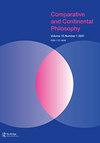Tetralemma and Trinity: An Essay on Buddhist and Christian Ontologies
IF 0.3
0 PHILOSOPHY
引用次数: 0
Abstract
ABSTRACT This is an essay in comparative philosophy and philosophy of religion building on the ontological claims espoused by two major thinkers in the Buddhist and Christian philosophical traditions: Nāgārjuna (c. 150–250) and Hegel (1770–1831). I use Nāgārjuna’s fourfold tetralemma (catuṣkoṭi) and Hegel’s threefold dialectic (Dialektik) to propose a novel understanding of the ontological status of the self in its relation to itself and to its other, the no-self. Thus, I apply the tetralemma to the self, arguing that, to attain ontic completion, the self must itself reflect the tetralemmic form in the totality of its being – nothing – both-being-and-nothing – neither-being-nor-nothing. These in turn correspond to the Hegelian in-itself, for-another, both-in-itself-and-for-another, and neither-in-itself-nor-for-another.四律与三位一体:佛教与基督教本体论论丛
摘要:这是一篇关于比较哲学和宗教哲学的文章,基于佛教和基督教哲学传统中两位主要思想家的本体论主张:Nāgārjuna(约150–250)和黑格尔(1770–1831)。我使用Nāgārjuna的四重四引理(catuṣ击倒取胜ṭi) 以及黑格尔的三重辩证法(Dialektik),提出了对自我的本体论地位的新颖理解,即自我与自身和另一个无自我的关系。因此,我将四引理应用于自我,认为为了实现本体的完成,自我本身必须在其存在的整体中反映四引理形式——没有——既有也没有——既没有也没有。这些反过来对应于黑格尔本身,对应于另一个,既对应于自身,也对应于他人,既不对应于自身也不对应于他人。
本文章由计算机程序翻译,如有差异,请以英文原文为准。
求助全文
约1分钟内获得全文
求助全文

 求助内容:
求助内容: 应助结果提醒方式:
应助结果提醒方式:


